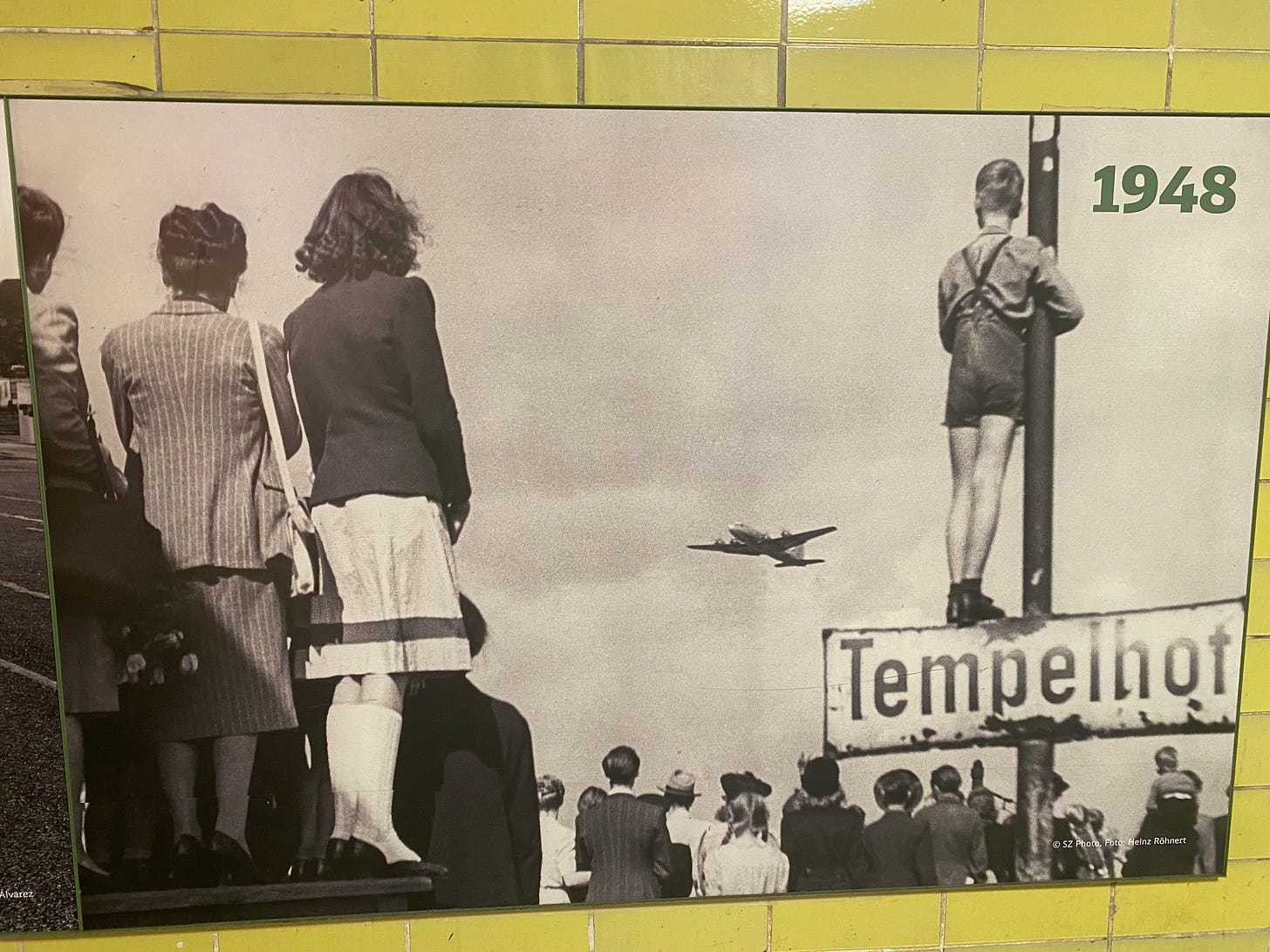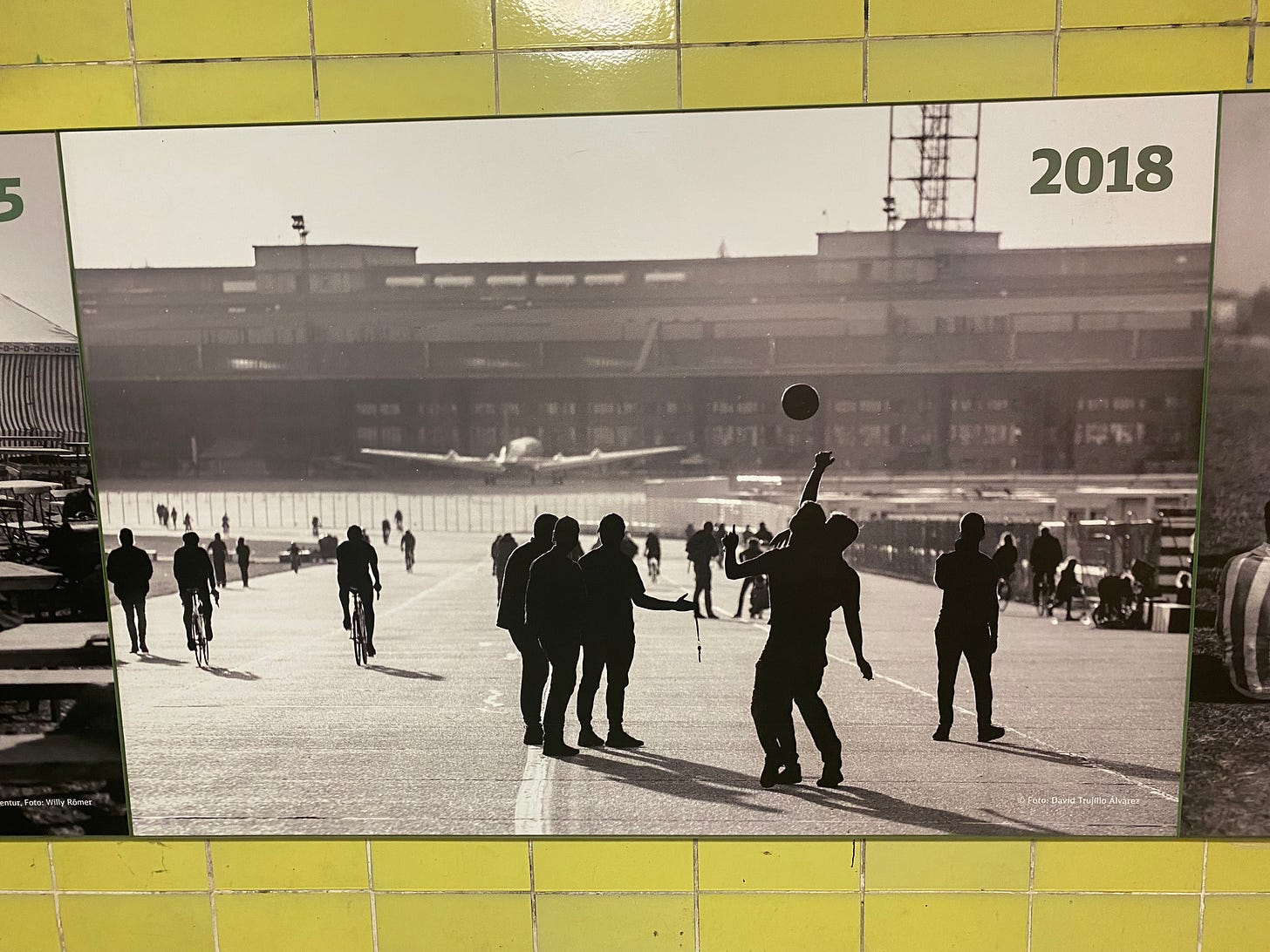The accidental rewilding of an airport
From West Berlin to West London
If I had to live in a city other than London it would be Berlin.
My first trip there was on a winter’s day in the middle of the 80s with my brother. We made it in a beat-up right-hand drive Renault 5.
At the time I was working in Düsseldorf, in what was then called ‘West Germany’. It was before the Berlin Wall came down.
I will never forget that drive.
The journey was nearly 400 miles. It was snowing. The roads were icy. And I had no snow chains.
The grim-faced border guards at the East German border looked like they had just stepped out of a Len Deighton 60’s spy thriller.
In other words, scary.
If you strayed off the road or exceeded the speed limit on the corridor to Berlin you risked a large fine or possibly worse.
We were sweating bullets the whole way.
But once we arrived I fell in love with what later became Germany’s capital once more. We swanned around the city like we were Iggy and Bowie, albeit a decade late.
Although some might say we looked more like we were casting for Wham’s ‘Last Christmas’ video.
20 years later I dragged my family to the reunified Berlin as often as I could get away with. We would exchange our house with flats in the old Soviet sector. You could see the city gentrifying, year by year, street by street.
I loved the similarities with my own city.
The abrupt changes in the streets where war-time bombs had fallen, London and Berlin’s diversity-driven dynamism and full-on histories. Sometimes too full - one of many reasons why both cities have the best museums.
That was all before I woke up to ‘accidental rewilding’. That’s when I realised there were even more reasons to be in love with my second city.
There was even an impromptu cricket match going on.
In 2022 I saw a completely different side to Berlin. This time we were staying in a district of the city that I had never explored before.
Back in the summer of 1948, the Cold War was heating up. Berlin was divided into four sectors, each one occupied by one of the victorious Allies in the Second World War. Those administered by the Americans, Brits and French amalgamated into what eventually became West Berlin for the next 40 years. The Soviets held the rest as what we knew as East Berlin.
Given that West Berlin was effectively an island surrounded by East Germany, it was always a vulnerable place when Cold War tensions ratcheted up.
That’s exactly what happened in 1948 when all roads, railways and canals in and out of West Berlin were blockaded by the Soviets in an effort to literally freeze the western Allies out of the city.
That’s when the western allies made the incredibly brave decision to provision their half of the city and its population by air. At the height of the airlift which lasted three months, a plane was arriving every 30 seconds, bringing in fuel and food, most of it into Tempelhof airport near where we were staying that week.
By the time the 21st century came along, Tempelhof was no longer an airport. This massive space of 355 hectares had been in effect squatted by the community. In 2010 it re-opened as the ‘Tempelhofer Feld’, the largest inner city open space in the world and a playground for the whole city.
Attempts by the city authorities to parcel off the land to developers encountered significant push-back from the citizens of Berlin.
That sunny June evening we arrived at the park it was being used for all manner of activities - running, cycling, skateboarding, kite surfing. There was even an impromptu cricket match going on.
As we walked further on to what had been the main runway in times past, we realised that major sections of the adjoining fields had been roped off for re-wilding.
Above the protected meadows there were dozens of skylarks, singing for all their worth. They were trying to distract the population of kestrels that had been attracted by the easy pickings to be had from their chicks nesting in the undergrowth.
Berlin has a history of encouraging urban biodiversity.
This was a city truly beaten up by war. Post 1945 debris-strewn and untidy Berlin became a unique chance to study what happens in cities when nature is left to itself.
These stretches of waste-land even acquired a name - the ‘brachen’ or fallow fields.
What were thought of as eyesores were in fact wonders of biodiversity. Academics and activists came together to protect these sites where people could harvest mushrooms, pick fruits, appreciate wildflowers and where children could just play1.
That post-war spirit has carried over into the 21st century at Tempelhofer Feld.
It was also the reason for the profusion of swifts and martins we noticed in the surrounding streets. They were nesting in apartment blocks whose eaves had not been blocked off in the name of progress as would have been the case in London.
I also discovered that Berlin is a stronghold for nightingales and goshawks, two species of birds that had disappeared from London centuries ago.
I left Berlin both bowled over but also a bit depressed at how far behind my own city felt in terms of biodiversity.
That was until I came across another ‘neglected’ patch of land closer to home in west London. It wasn’t an airport but it was within a stone’s throw of Heathrow.
I had known of Warren Farm when I was bringing up my own family in Ealing. I had never seen it as a farm but it figured strongly in my memories when it became playing fields.
My weekly runs would take me round the perimeter. But I never thought of it as a preserve of nature given that it was in the shadow of both the airport and the elevated section of the M4.
15 years ago the playing fields were abandoned and the council were going to turn it over to landfill until the community mobilised just as they had in Berlin at Tempelhof.
Led by young conservationist Kabir Kaul, a regular on BBC’s Springwatch, they highlighted the thriving diversity of what looked like just a set of scrubby old fields.
The now derelict changing rooms gave both a dystopian vibe and a home to rare plant species and voles.
A survey revealed that a quarter of London’s skylark population lived on these 60 odd acres of urban meadow just like at Tempelhofer Feld in Berlin.
That in turn had attracted birds of prey - I spotted four species there on a single day as well as different types of owl.
Imagine my joy one day in early September to look up and see dozens and dozens of swifts feeding up high up on the meadow’s invertebrates, in numbers I had never encountered before in London.
As one of nature’s best fliers, swifts have inspired leading edge aircraft design since the dawn of aviation including Concorde with its delta wing.
That supersonic plane may no longer be overflying the reserve on its descent into Heathrow. But if it did it would look lumbering compared to the birds that originally inspired it.
Happily people power won the day in Ealing as it had in Berlin.
In 2024 the council has promised to pursue Local Nature Reserve status for Warren Farm, not quite legal protection but getting that way.
Perhaps one day it will be home to goshawks and nightingales too.
We can all dream, can’t we?
I am indebted to Ben Wilson’s ‘Urban Jungle’ on the history of Berlin’s re-wilding











Hi Ronnie, the soundtrack to that drive was more likely to be 'Always crashing in the same car', a track from my favourite Bowie album, Low.
And as for your aerodrome, I think there might be a book idea in there. Don't forget Greenham Common too....
I like the sound of Berlin and their Templehof. As well as the image of you and your brother as Iggy and Bowie. I trust you sang Iggy’s “Passenger” on that long drive? And, by the way, there’s a little Templehof copy here. The former Speke Aerodrome down by the river. Now a nature reserve, with gently crumbling old runways.